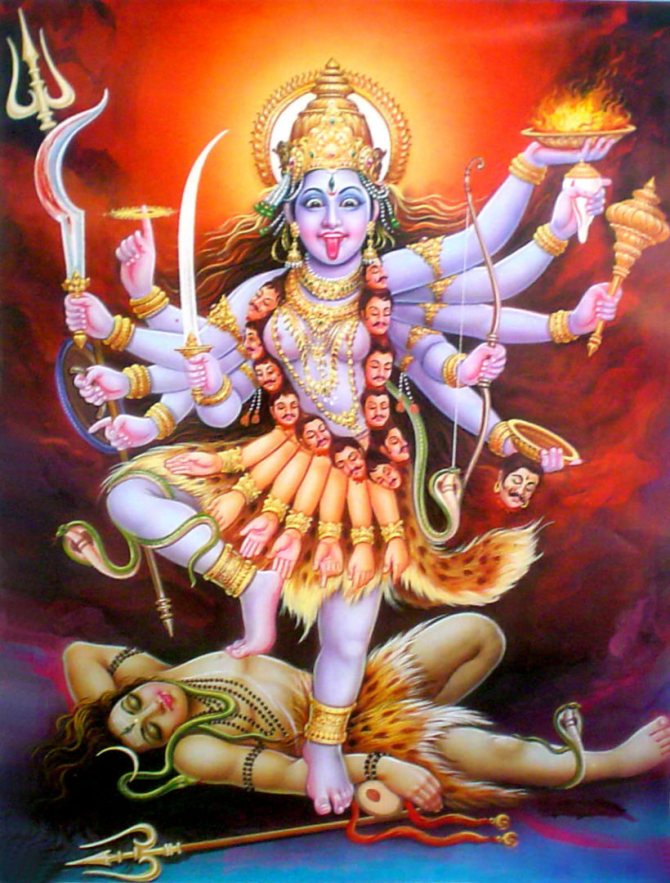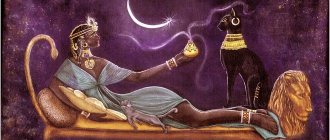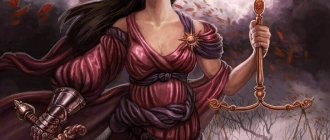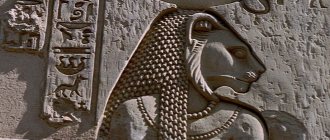O formidable goddess, glorified as the Mother of Peace! Beautiful art thou, O Moon in the curls of Shiva! Blessed art thou, O Primordial Energy And source of all beings!"
Maha Kali-Chalisa1
Kali (Sanskrit काली, Kālī, 'dark; time') is the goddess revered as the inexorable force of time, consort of Shiva. The most powerful form of Shakti, she is fierce and wrathful, a destructive manifestation of cosmic energy. She is the fierce aspect of the goddess Durga (Parvati). The embodiment of fear, while she herself is beyond it. In the Vedic scriptures the name "Kali" is mentioned as one of the seven tongues of flame Agni, which is the fire of transformation of matter into energy.
Kali is the mother goddess, caring and protecting her children from evil forces. Destroying demons and all appearances of evil. Giving liberation from the cycle of rebirths. Protectress of the gods. Many sources praise Kali as the highest reality or the greatest of all the deities. She is personified cosmic forces, the manifestation of the kinetic energy of Creation, creative force, setting in motion the universe, giving rise to the Creation, and at the same time, destructive force, leading to the end of the world.
Kali is the goddess of Time, the hypostasis of the cyclicity of existence and the process of changing eras and worlds, life and death. She brings rebirth through death and destruction of old forms. Kali is a manifestation of an aspect of Time of Mother Nature. She is the energy of transformation, change and transformation. Kali is the transforming power, yet she herself always remains unchanged.
Kali is a destructive force for the Ego, terrifying and crushing egoistic tendencies and ignorance. She dispenses with illusions. Her essence is not violence, as can be mistakenly interpreted from images and descriptions of the goddess, but the true grace of Mother Nature.
Kali is the force that absorbs previously created by her, manifesting as Time and dissolving into the dark chaos of disorder, the Void or original energy. It absorbs all things at the end of time. Her garment is space.

The image of Mahakali. Painted by: V. V. Sapar
The name Kali - etymology
The name Kali (काली, kālī) in Sanskrit is the feminine form of the masculine noun kala (Sanskrit काल, kāla) 'time, destiny', and represents the nature of Time, its essence and completeness. Since Kāla is an epithet of Shiva, meaning 'eternal Time', the name of his consort Kali also means 'Time' or 'death' (in the sense that time inevitably brings life to an end). The name Kali means that she is the goddess of Time and Change.
Kālī is also derived from kāla (Sanskrit काल - 'black, dark, dark blue'). The name Kali, meaning 'Black', indicates the original darkness (not the opposite of light). Black, as we know, does not reflect white light, it absorbs it, and therefore black does not radiate energy, but absorbs it. Just as "Black" Kali absorbs energies. Therefore, in this meaning her name means 'all-encompassing, fullness'.
Also among the meanings of the name in Sanskrit are the following translations: 'defeat, bad luck, sin, suffering, quarrel, strife'.
.
It is interesting to note that the identical root bases of the ancient Proto-language 'kal' and 'kol' contain the same meaning - kolo, circle or wheel of Time. The wheel of Kala symbolizes the eternal return to the Source. The wheel is also the oldest symbol of the Sun, which was revered by our ancestors.
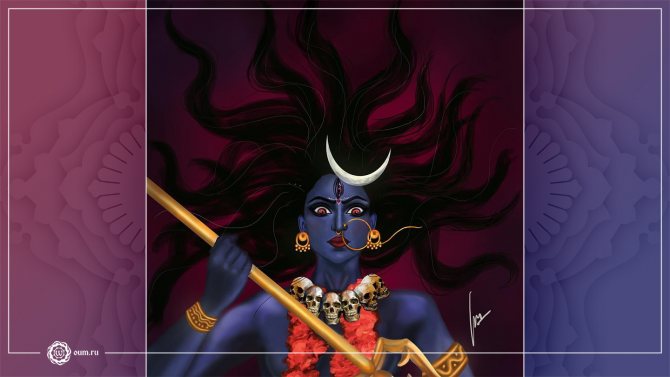

Meaning for men
Often Kali tattoos are done by men. They prefer to make beautiful drawings on the body in the technique of tribal and graphic.
They often choose colorful images of the goddess. Less often they give preference to black and white drawings. For members of the stronger sex, a tattoo in the form of Kali means:
A spectacular tattoo in the form of Kali will tell about the soulfulness and wisdom of its owner.
A man with such a body image for sure a religious man and dreams with all his heart to get closer to God.
Sometimes these images on their chests are chosen by the representatives of the stronger sex, not because of the special symbolic value, but because of the originality of the picture.
The names of Goddess Kali
Goddess Kali is also known as Kalaratri (Sanskrit कालरात्रि, Kālarātri - 'black night'), Kalika (Sanskrit कालिका, Kālikā - 'temporary, continuing over time'), Shyāma (Sanskrit श्य, Kālikā - 'temporary, continuing over time'). श्याम, śyāma, 'black, black'), Krishna (Sanskrit कृष्णा, kṛṣṇā, 'black') or Krishnamatra (Sanskrit. कृष्णमात्रे, kṛṣṇamātre - 'Mother of the original Darkness'). She is also Karalika (Sanskrit करालिका, karālikā - 'inducing terror'), Karālikaja (Sanskrit रालिका, karālikā - 'inducing horror'), Karālikaja (Sanskrit कराल, karālikaja). करालास्या, karālāsyā - 'possessing a terrifying countenance'), Kamahartri (Sanskrit कामहर्त्रइ, kāmahartri - 'destroying desires'). She is also Kartri (Sanskrit कर्त्रइ, kartri - 'creating, creating, acting force'), Kritya (Sanskrit कृर्त्रइ, kartri - 'creating, creating, acting force'). कृत्या, kṛtyā - 'being the very action'), Karyakari (Sanskrit कार्यकरइ, kāryakari - 'the power of action residing in every action'). She is Kakini (Sanskrit काकिनइ, kākini - 'goddess of the fourth yuga'). All 108 names of Kali goddess.
, presented in Kali Ashtottarashata Nama, can be found here.


Kali Shapes
Kali is one of the 10 forms, or manifestations, of Mahadevi, which are referred to by the Sanskrit term 'Dashamahāvidya' (Sanskrit दशमहावद्या, daśamahāvidyā), literally meaning 'The Ten Great Knowledge'. This group of ten tantric goddesses, each of which is a separate aspect of the Mother-Goddess. According to the Shiva Purana, Kali is one of the nine forms of Durga ("Navadurga").
In various traditions Kali has 8, 12 or 21 forms, the best known among which are: Adya-Kali, Chintamani-Kali, Sparshamani-Kali, Santati-Kali, Siddhi-Kali, Dakshina-Kali, Bhadra-Kali, Smashana-Kali, Adharvanabhadra-Kali, Kamakala-Kali, Guhya-Kali, Hamsa-Kali and Kalasankarshini-Kali. "Mahakala-samhita" mentions nine forms of Kali, among them: Dakshina-Kali, Shmashana-Kali, Bhadra-Kali, Guhya-Kali, Kala-Kali, Kamakala-Kali, Dhana-Kali, Siddha-Kali and Chandika-Kali. She is also worshipped in the form of the Great Mother Maha-Kali. Let us consider the most popular forms especially worshipped in Bengal, where the cult of Goddess Kali is most prevalent.
- Adya-Kali
- Literally 'Primordial Kali', or the supreme Shakti power of all things. - Dakshinakali
- the gentlest form of Kali, especially revered in India, bestowing good motherly care and protection from misfortune. "Dakshina" means 'gift' presented to a guru for knowledge or to a clergyman before performing ritual and ritual, also 'dakshina' is 'south' (the side of the world ruled by the god Yama who, according to legend, fled in terror when he heard the name Kali), so the meaning of Dakshinakali is 'blessing Kali' and 'giving benefits to Kali' as well as 'Powerful Kali who overcomes death'. - Samhara-Kali
, or Vama-Kali, is the most terrifying and powerful form of Kali, appearing as the personification of death and destruction, but also as the giver of liberation. - Raksha-Kali
- A form of Kali worshipped to protect against epidemics and drought. - Bhadra-Kali
- 'Devouring flame', a fierce and terrible but beneficial form of Kali, as she acts as the protector of good. - Guhya-Kali
- The personification of Kali's eternal wisdom. The intimidating form of the goddess. - Siddhi Kali
- The beautiful form of the goddess, bringing spiritual benefits and filling with vitality. - Chandika-Kali
- The embodiment of Truth and spiritual wisdom, dissolving barriers on the Path.
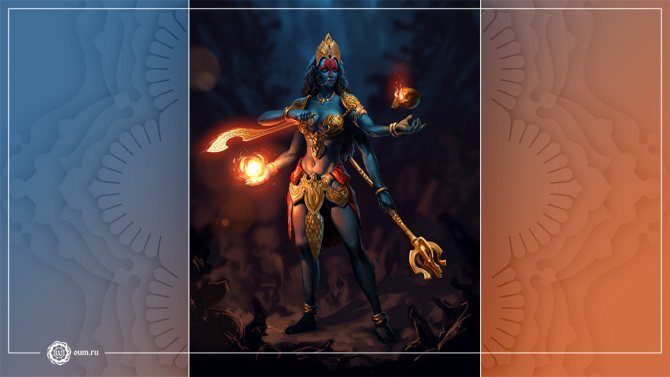

Choosing a style to match the goddess
Dotwork is a great option for fans of monochrome tattooing. The traditional Indian ornament, which often adorns the portrait of Kali, looks very impressive in this style, especially if the work is large enough. Sometimes tattoos are performed in two colors - black and red. Such images look quite contrasting, and a lot of small details that make up a complex ornate Indian ornament, attracts the eye, forcing to consider each element.
Lovers of bright colors should consider the options of works in the style of newscool. It knows no strict limits, so you can feel free to fantasize. Newsculpture is not only vivid, but also quite emotional, it is one of those styles that allows you to convey the story as accessible to the viewer as possible, and most importantly - to evoke a certain emotion.
Take into account that a beautiful tattoo with Kali is unlikely to be small. The image of the goddess requires a certain amount of detail, so most often her portrait occupies the entire forearm, shoulder, thigh or lower leg. There are also large-scale paintings on the entire back that tell a whole story.
Interestingly, in India, tattoos have never been banned by law (only members of the armed forces have not been allowed to wear a tattoo since 2011), which is not the case in many other countries. Moreover, while in European countries a tattooed person was often immediately attributed a questionable past or considered a tattoo a sign of immaturity, in India quality work is considered an indicator of wealth and high status. For example, most Bollywood stars have at least one tattoo.
Kali - Mahakali
"The Great Goddess is the energy of the world as well as its will, and she is always active as a force set in motion; she abides in the world according to its nature."
"Yoga Vasishtha."
Mahākālī (Sanskrit हाकाली, Mahākālī - 'Great Kali') is the highest form of Brahman and one of the three main forms of the Mother Goddess, Maha-Devi, whose other two forms are Mahālakshmi and Mahasarasvati. She is a powerful cosmic aspect and represents the Thamas guna.
. In the form of Mahakali, the Great Goddess represents the cyclical aspect of existence and maintains the cosmic order. Mahakali is depicted with ten heads and hands. Each of her ten hands contains an attribute of one of the devas, representing his power. The implication here is that Mahakali is responsible for all the powers that these deities are, that is, Mahakali contains all the powers of the Universe.
Everything was created out of the original darkness, and Kali's dark appearance represents this darkness that gave birth to the whole world. Maha Kali is also revered as the guardian of nature, the loving and kind mother goddess. Millions of people venerate her in this aspect - as Kali Ma, that is, Supreme Mother Kali.


The image and symbolism of the goddess Kali
"Goddess Kali dances around, armed with an axe and other formidable weapons, dressed in wreaths of flowers." "She is depicted with flames on her head and with a dry and desiccated body - as a symbol of her desiccating (destructive) rage."
"Yoga Vasishtha" (book VII, chapter LXXXIV)
There are many different depictions of the various forms of Kali. The most common are the forms of Kali with either four or ten hands. In these forms she appears as black in color, but is most often depicted as blue. Her eyes are red with rage and anger. Her hair is disheveled, with a red tongue sticking out of her mouth. Kali is also often depicted with a belt of human hands and a garland of human heads. She is accompanied by snakes and jackals drinking blood from the head of the demon Raktabiji, which Kali holds in her hand. Classical depictions of the goddess Kali are characterized by common features: she holds a sickle-shaped sword in one hand, a trident in the other, a severed demon's head in the third and a bowl in the fourth.
With ten hands she appears in the form of Mahakali
in which in different variations of the images she holds: a saber, a sword, a trident, a demon's head, a bowl, a shell, a bow, an arrow, a sudarshan-chakra, a bowl of fiery flame, a rod, a sword, a harness. She has ten faces and three eyes on each head.
"The Kalika-purana describes Kali as having a dark complexion, riding a lion, with four hands in which she holds a sword and blue lotuses. She shines with beauty and eternal youth.
Sword
symbolizes the divine knowledge that breaks the shackles of ignorance and cuts off the fetters of selfishness.
The head of the demon
represents the Ego, which must be overthrown by true knowledge. The red color of its tongue, like the scarlet hibiscus2 , symbolizes the dynamic Nature of Life, guna rajas, action, movement, activity.
A garland of demon skulls
, overcome by her in battle, in which she acts as a force of righteous anger, destroying evil, is, according to one version, a figurative reference to the 50 letters of the Sanskrit alphabet, which symbolize the manifold manifested Universe, where sound and speech represent the material form, the duality of perception. They constitute the Universe, which Kali absorbs at the end of time, dissolving them, and Creation disappears into it.
Another version suggests that the heads symbolize the reincarnations through which Spirit (Consciousness) passes. The belt of hands
figuratively indicates that each person has multiple attachments to the world of forms or karmic consequences of each of their lives.
The three eyes
may refer to time: past, present and future; but they may also be a symbolic indication that Kali governs Time in all three cycles of existence: Creation, Preservation and Destruction.
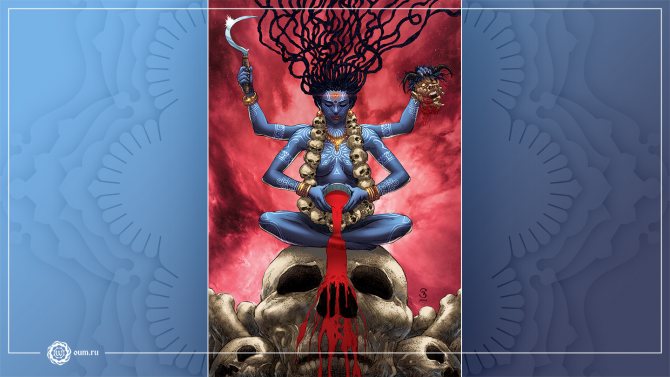

In some depictions one hand of Kali is folded in a gesture of fearlessness (abhaya-mudra) and the other in a gesture of blessing (varada-mudra). These gestures mean that the goddess Kali will always protect and deliver from fear, blessing the victory over one's conditioned perception.
Distorted Reality.
Kali is usually depicted with a menacing, intimidating expression, a tongue sticking out, and severed human heads as entourage. Such a character clearly does not bode well for Europeans. But we often forget how essential the differences in perception of different peoples are sometimes, and continue to look at everything through the prism of our own worldview, formed by completely different cultural traditions.
The name of the goddess is translated as "black. "Mahanirvana Tantra" says that black includes all existing colors, and so the goddess contains all aspects of the essence of all living things. One of her names is Kalikamata, which means "black earth mother. In this sense, it is the wisdom and the power of the goddess of destruction, but it is the destruction of the shackles of ignorance and the erasure of all that prevents a person from knowing God, from gaining wisdom and from becoming exalted. Kali teaches her earthly children that there is a long way to gain wisdom and eternal bliss, much will have to be sacrificed on the way, and the soul will have more than one rebirth, and the body more than one death, before this path will be passed.
This is why many Europeans perceive Kali as an evil goddess, because in Indian culture the perception of death is quite different. If for us death is evil, an old woman with a scythe who takes away our relatives and loved ones, ruthless and unfair, Hindus see death as just another stage in the eternal life of the spirit.
The cult of Kali gained notoriety thanks to the Tugas, the fanatics who robbed and killed under her name. According to some estimates, over a hundred years (XVII-XVIII centuries), the Tugas murdered about two million people. However, there is an opinion that this is nothing more than fiction. Many historians believe that legends of bloodthirsty murderers were deliberately spread among the population. In this way the British administration covered up radical actions to maintain order in the conquered territories. According to historians adhering to this theory, the captured and convicted Tugas were in fact simply elements undesirable to the new authorities, on whom all sorts of accusations were "hung.


Kali: origins and legends
There are various legends in the scriptures describing the appearance of the goddess Kali. According to one, Kali emerges from Vishnu, presenting her formidable image to the forces of evil and protection for the bright forces of the Universe. In another legend, she appears from the forehead of the goddess Durga, appearing as a force to crush demonic manifestations. Here she represents the wrath of Durga, her embodied fury. The demons that Kali kills symbolize the consequences of false self-identification, attachments, illusory perception and such manifestations of false Ego as vanity, pride, greed, self-interest, envy, etc.
Kali as Yoga-Nidra, the protective power of Vishnu
The first mention of the goddess Kali is in the Devi-Mahatmya. Here she appears as Mahakali, appearing from the body of sleeping Vishnu in the image of the goddess Yoga-Nidra, in order to awaken him and protect the world from two demons: Madhu (personification of flattery, seduction and pretense) and Kaithabha (image of guile, cunning and deceit). After Vishnu awakened, he fought the two demons but could not defeat them, then Kali, taking the form of Maha Maya, enchanted them, so this time Vishnu was easily defeated by these two demonic forces.
Kali - born of Durga's wrath
In "Devi-Maha, song LXXXVII) tells how two demons Chanda (manifestation of malice) and Munda (personification of stupidity) attack goddess Durga, who in anger takes the form of Kali: her face becomes a dark color, and the goddess Kali comes out of her forehead. Kali, who fills the space around her with a terrifying roar, appears in a terrifying image:
"Kali with a terrible face of dark blue color, armed with a sword and a noose, carrying a multicolored staff with a skull on top, she is wearing a garland of skulls, she is dressed in a tiger skin, emaciated, with her mouth wide open with her tongue sticking out, with deeply sunken reddish eyes."
"The Markandeya Purana, Song LXXXVII.
She battles two demons and their entire mighty army. Whereupon the demon Raktabija ('Blood Seed'), invincible because of his ability to reproduce from every drop of his blood that fell to the ground, was killed by Kali. The goddess slew Raktabija with her dart, thunder arrow, sword and spear, and consumed his blood before it reached the earth, then destroyed all the doubles he spawned.
"From Ambiqa's fiercely frowning forehead, Kali suddenly appeared with a terrible face, armed with a sword and a noose. She swiftly attacked the demons and devoured these hordes of enemies of the devas."
"The Markandeya Purana, Song LXXXVIII
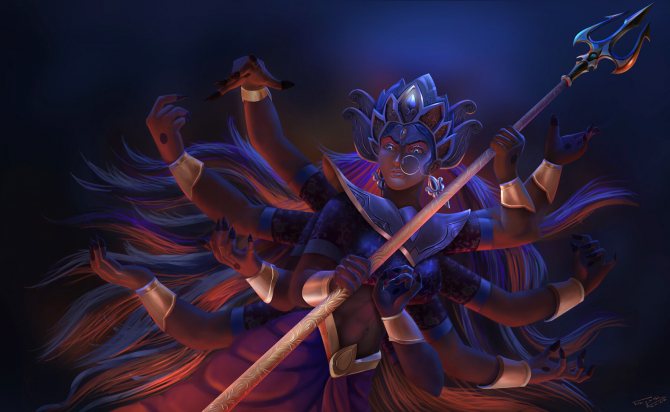

The image of Durga.
This is interesting.
Goddess Durga, the incomprehensible divine energy of shakti
Goddess Durga is one of the main, especially revered goddesses in the Vedic pantheon. She represents the energy that opposes the forces that threaten prosperity and the light Dharma. She also manifests as the force that destroys the universe before a new Creation, due to which there is a change in the cycles of existence of the universe. Durga is a manifestation of the feminine divine beginning - shakti.
Kali is the offspring of Shiva
Other stories of Kali's origin ("Linga-purana") are related to Parvati and Shiva. Parvati is a merciful and benevolent goddess, but when Shiva asks her to defeat the demon Daruka, who has the blessing of being killed only by a woman, Parvati merges with Shiva's body and manifests as Kali, who mercilessly crushes demons.
Shiva and Kali
"The original cause of all things, the divine power of the Will sought to take any manifested form of Nature."
"Yoga Vasishtha."
Kali is most often seen as Shakti of Shiva. In the legends where Kali slays demons, her anger is out of control, but only Shiva can pacify her. They are two polarities and at the same time one indivisible whole.
The most famous depiction of Kali is where she stands (or dances) on her consort, the god Shiva. Consider what symbolism is hidden in this image and what meaning it carries.
- According to one version, when Kali is depicted with her foot trampling Shiva lying lifeless on the ground, in this image she represents the force that destroys Life. Shiva here symbolically appears as nothingness, in which there are no powers of life. Kali carries them away into eternity and impermanence. From this moment comes Pralaya, or the period of the Great Dissolution of the world, in which there is nothing but the power of destruction - the power of Kali.
- Also the white body of Shiva (as radiating the light of pure Consciousness) is an image of the transcendental state of Consciousness. He is immovable because he is not subject to change. He is an unchanging aspect of the Supreme. Shiva is Purusha and Kali is Prakriti, Nature itself, energy. Whereas Kali is the driving force of Time, which is the changing aspect of the Supreme. Shiva in this case appears as Nirguna, who is outside the gunas, or qualities of Nature. And Kali appears as Saguna, i.e. possessing all the qualities of material existence, but at the same time unaffected by them.
- Both Shiva and Kali together are one and the same. Shiva without energy cannot exist in the manifested being and fulfill his role in the evolutionary process of all living beings. Therefore Shiva without his Shakti is just a lifeless corpse, unable to act.
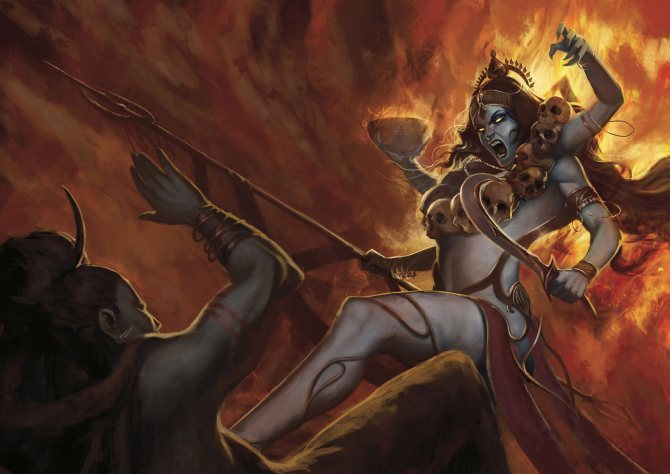

Shiva and Mahakali
As the Yoga Vasishtha (book VII, chapter LXXXIV, "The Union of Shiva and Shakti") states: like the wind and its gusts, like fire and its warmth and fiery outbursts, like the Ocean and the waves, Shiva is Consciousness, and Shakti is the vibrations that cause changes in Consciousness.
"Shiva is perfectly calm without his will or desire, which is his feminine energy, Kali."
"Yoga Vasishtha."
Shiva is always the personification of formless emptiness and peace, Shakti Kali manifests it in form and action, so she is depicted dancing - for her very essence is movement, active manifestation. Power always remains potentially in inertia. So also. Shakti Kali is the power of Consciousness, always in action, in "dance.
. We see this dance of the Universe all around us: the planets rotate on their axis and orbit around the central luminary, the galaxies are always in orbit. This is how Kali, as an eternally in motion energy, sustains the existence of the entire Universe.
This is interesting
The divine energy of Shakti
Shakti, the goddess, is represented in Shivaism, the religion prevalent in India, as the other half or hypostasis of Shiva. For someone raised in the Western tradition, it may not be easy to imagine that Shakti can also be a goddess in her own right, manifesting as Kali, Durga, Parvati, Lakshmi, Saraswati and others in the Vedic tradition and as an inner part of Shiva.
"The movements of the dancing Kali (God's creative energy) cause no fluctuation in the world contained within it; just as the shaking of a mirror causes no change in the reflection that is cast upon it."
"Yoga Vasishtha."
Any material object is compacted energy, i.e. energy in motion. The greater the velocity of the particles composing the object (energy vibration frequency), the thinner and more orderly its structure is. Conversely, the lower the frequency of vibration, the "rougher" the material substance. The frequency of vibrations indicates the degree of "development" of consciousness of a particular manifestation of Life in the material world.
Thanks to ShaktiKali this world became visible and tangible. She embodies the Will of Shiva into life. Nature or the material world is cognized through the organs of perception, and the experience of this cognition contributes to our advancement on the path of evolution. Kali is the essence of all transient phenomena of this world, taking them into eternity.
"Yoga Vasishtha (Book VII, Chapter LXXXV, "The Relationship of Nature and Soul") reveals the meaning of the symbolic union of Shiva and Shakti in dance as the image of the indissoluble eternal union of Shiva and Shakti - Consciousness and Energy (Nature). A ray of Consciousness (attention) directed at an object creates a vibration of energy in it, but when attention runs out, the object returns to its original state of potential being. This is the continuous process of creating matter from energy and vice versa - the transformation of matter into energy, which could not take place without the participation of Consciousness. Their union is the basis of all of Creation's existence.
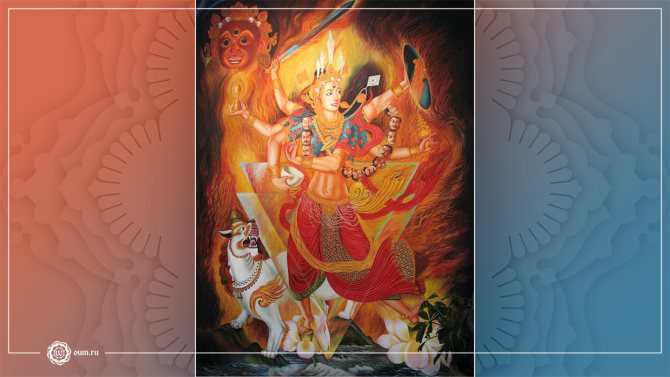

Masculine, feminine and creative
The image of Shiva lying beneath Kali's feet symbolizes not only the superiority of the spiritual aspect of existence over the physical.but also the passive masculine potential of creation. Kali, his consort, is also his "shakti" (this word has many meanings, including "power," "strength," divine energy, etc.) - i.e., the female beginning of creation, charging the power of the male deity.
Another name of Shakti Shiva is Davi, from the root "div", which means "brilliance. Therefore this goddess is called "radiant. Shakti expresses the life-giving power of the universe and is reflected in the very name of Shiva: in the absence of shakti, Shiva becomes simply "shva", which in Sanskrit means "corpse". Thus, it is assumed that without his shakti Shiva is powerless, inert or simply dead.
The image of Kali is most suited to represent the idea of the world as a game of the gods. Spontaneous, dizzying creative reflexes are conveyed in her wild appearance. Because Kali is identified with the phenomenal world, she presents a picture of that world that is ephemeral and unpredictable.
Her frantic dancing, disheveled hair, and creepy howling are a hint of our worldthat rattles and rattles away into infinity, beyond human control. All things are created and destroyed in Kali's wild danceThe black goddess is the source of inspiration for all creative people, and in the first place for all creative people, the black goddess is a source of inspiration.
With all this in mind, it is clear that the Black Goddess is considered a source of inspiration for all creative people, and in the first place poets, whom she considers her favorites and chosen ones..
The goddess Kali: the destructive aspect of Time
Kali's volatile "disposition" is evident in the nature of Time. Kali embodies the changing aspect of Nature that leads to life or death. Kali is the embodiment of Time or the "Supreme Night" in which all things dissolve.
In the Mahanirvana-tantra Kali is an epithet of the original Shakti. Shiva himself praises her as the Great Primordial Kalika absorbing Mahakala herself (an epithet of Shiva meaning 'the Majestic Power of Time' or 'the Supreme Ruler of Time') at the end of time in the destruction of the universe. For it, being the Source and the original form (Adya) of all things, including being the Prime Cause of Time (Kala), absorbs it, absorbing it into itself. He calls it inexpressible and incomprehensible, because it, returning to its form (Svarupa), merges with the primordial darkness, unexpressed and formless. It is the Beginning of all things, the Defense of all things and the End of all things.
The destructive aspect is inherent in Mother Nature herself and manifests itself as the force of Time. Nothing exists forever in the material world - everything, once created, is doomed to destruction.
This power of Kali (Time) resides in matter itself. Everything in this world is subject to the processes of aging and dying. Creation is a process of ordering, organizing form and organic life, while Destruction is a return to disorder (chaos). Kali facilitates these cyclical processes by which life is reborn again and again. For nothing in the universe dies, it just changes its form of manifestation.
.
This is how the destructive power of Kali manifests itself: every material object in our world is energy in motion. This energy fills the whole world. It is Mother Nature, Matter, a manifested being that exists in time and space. Outside of time, all things simply cease to exist. Matter exists according to the laws of time. And time manifests itself only in motion. All forms of matter change every second. Nothing stands still, everything is subject to change. Where the aspect of time is manifested, there is destruction, so the nature of the entire material world is transient and not eternal.
Kali's power is akin to the action of a black hole in space, sucking into itself whatever approaches it. As is known, matter from energy is formed on the outskirts of the galaxy, but closer to the center it is condensed, after which it is drawn into itself by the black hole, which is in the center, in order to convert it into energy again. Kali as pre-matter, from which primary matter emerges, takes it back at the end of the cycle of existence. This is the eternal law of Nature and Time. Everything is in constant motion and in the process of change and transformation that Mother Nature maintains.
The action of the power of Kali as Mistress Tamoguna can be observed in the processes of aging and fading of life forces in us and other living beings. The cyclicality of existence in organic life within a single incarnation is a reflection, at the level of microcosm, of all processes occurring in the Universe, which also is born, exists and dies. Thus, one can visually compare the periods of human life and the epochs of the world's existence during one Maha-yuga3.
"Morning" of human life or childhood is identical to the sattvic (pure) energy manifestations of Satya-yuga (or Krita-yuga), which gives the beginning to the whole cycle of the Universe life. Following comes the "daytime" or youth in human life; it corresponds to the sattvic-rajasthic, active energies of Treta-yuga. The "evening" period of life or time of man's maturity is similar in energies (rajasic-tamasic manifestations) to the epoch of Dvapara-yuga. And finally, dying of vital forces or, figuratively speaking, "night" of human life, i.e. old age, is akin to the dark time of Kali-yuga with its inherent tamasstic, passive energies. We see that processes occurring during day (morning, day, evening, night) and year (change of seasons: spring, summer, autumn, and winter) are also influenced by Nature's gunas. Sattvic time comes in the morning with sunrise and lasts for three more dawn hours. The rajas of the day gains strength in the afternoon and lasts until the evening twilight. The influence of tamas lasts after sunset and all night until the morning twilight.
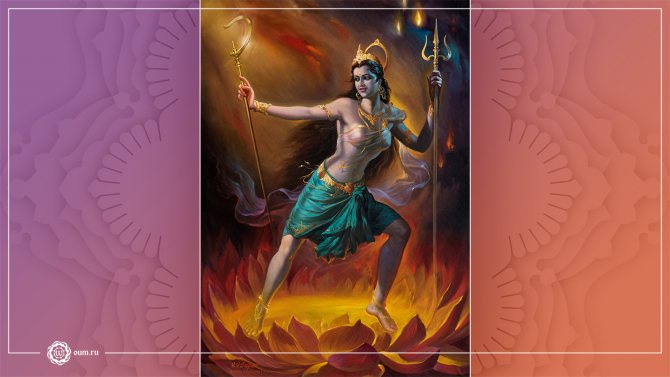

The image of Mahakali. Author of the picture: V. V. Sapar
The dawn of sattvic energies always manifests itself at the beginning of any time cycle, when everything around is awakened and filled with vitality, while the decline of life is always accompanied by tamasic manifestations of decay and decay. Sattva is always expansion, unfolding and light, rajas is equilibrium, and tamas, ruled by the goddess Kali, is contraction, contraction and darkness. This is why she is called the "Absorber of Time.
The change of seasons, which, by the way, occur differently in different parts of our planet, is also connected with abundance and absence of light. That is, the seasons of the year in the northern and southern hemispheres are always directly opposite to each other: when it is summer in the northern part of the Earth, it is winter in the southern part and vice versa. But everywhere and always there is one order, depending on the ratio of light and darkness: where there is more sun and light, there is sattva filling (spring, summer); correspondingly, the less sunlight, the more tamas (autumn, winter). Rajas as the guna of equilibrium is active during equinoxes, when the day is equal to the night.
This is interesting.
The god of time Koliada is the personification of the reborn winter sun
Kolyada - one of the bright solar gods of the Russian Vedic pantheon. God of the new Kolo, who is the personification of the reborn Sun. Kolyada - the god of time, who gave people the calendar and told us about the laws of the rotation of time cycles. He brings the winter sun to the sky, to the spring his way. The month dedicated to the god Koliada is December, in which they celebrate one of the main holy days of the annual Kolo, marking the arrival of the New Year - Koliada. Koliada opens the gates of the new Kolo - with the light of the renewed Sun the world enters into a new cycle of the annual Svarog Circle. God Koliada is one of the faces of the Sun, which in its annual (visible) way appears in various four hypostasis, passing through four key points in the firmament, corresponding to the four holy days of the year: the spring equinox, manifested by the face of the young growing Yarila-Sun, the summer solstice, manifested by the fierce power of the Sun-Kupala, the autumn equinox, shining with the face of the aging wise Khors-Sun, and the winter solstice, reborn by the renewed Sun-child Kolyada. God Koliada takes his rights from the winter solstice, when the Sun turns from winter to summer, and sees him off at Shrovetide, welcoming the spring Sun.
By the way, the day of the winter solstice, which is a day of veneration of the god Kolyada, the ruler of time, completing the annual cycle and launching the Colo of time to a new turn, can also be attributed to the goddess of time Kali. It is difficult not to notice in this case, the identity of the root bases of the names of the gods: KOLYada - KALI. Thus, summarizing all the above, we can safely assert that the goddess Kali as the ruler of tamas is the patroness of all that is under the influence of this guna, respectively, Kali is the goddess of night
, winter, old age and death, i.e. any final (final) period of time. The age of Kali Yuga is named after the goddess Kali for a reason, as at this time her power (the power of Time) is manifested most actively. Aspect of time and guna tamas become stronger, time speeds up its course, and it is especially evident closer to the end of the epoch.
Kali Yuga: the era of Kali
"If everything in the world goes contrary to the order established from above, it is a harbinger of doom.
"Mahabharata."
The seed of destructive energy increases its influence on life and all things by the end of time. By the way, it is related to this acceleration of time, which, by the way, has recently become all too obvious. We are approaching the end of the whole cycle of existence, and the inexorable running of time unobtrusively tells us that the end of time is not far off...
Kali Yuga is named after Kali, as destructive tendencies intensify during this period. Kali Yuga is considered the darkest time of the Maha Yuga, at the end of which the Satya Yuga or ascending cycle begins again. At the end of the last of the 1000 yugas, which make up the Brahma Day, comes the death of the worlds.
This is how the main tendencies of this final epoch are described in the Mahabharata (book III, chapter 186): all men become false; the vows become superficial; the Shudras live better than all others; the Vedas are forgotten; the sinful and deceitful Mlechchhas become kings; the Brahmans forget their Dharma, and the Kshatriyas and Vaishyas retreat from their duties; life is fleeting; the Shudras are honored in society, and the Brahmans are disrespected; corruption and impiety, greed and lust, lawlessness and apostasy; the exorbitant burden of tribute leads many to the path of fraud and theft; "people grow hair and nails for appearance"; "the age of him who is true to the Dharma is short," for the most virtuous are persecuted in society; the righteous are poor, while the last sinners and impious thrive, enriching themselves by deceit.
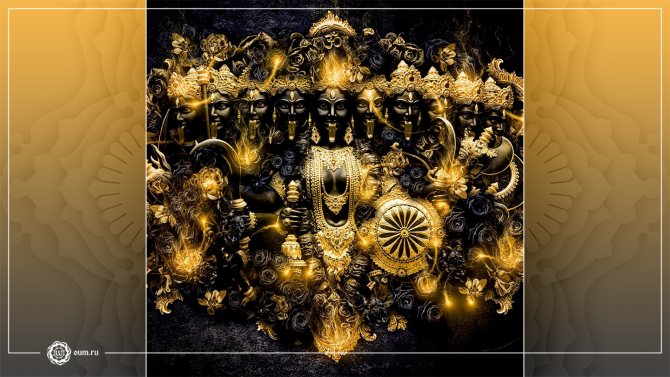

Kali - crushing the Ego
Time destroys everything, including the ego. Kali is the divine energy of Mother Nature in her destructive form. But she destroys in order to revive through purification and transformation - through her there is a renewal of the material form that is called to serve Consciousness on the Path of evolutionary ascent.
For the Ego, the great deception of Life is that everything it gave us in the beginning - that which we love and to which we are attached - it will inevitably take away. The inexorable course of time cannot be stopped.
Change brings suffering to the Ego, but it is necessary in a world of manifested forms, whose temporary and transitory nature leads to an awareness of what is really true and what is illusory.
"Kali is as fierce as the flames of the fire of destruction, fierce as the god of death on the battlefield."
"Shiva Purana," Rudra-samhita, chapter 38
Kali is also the force that destroys evil in all its manifestations, which are selfish tendencies. Egoism manifests itself through a false self-identification with that temporal personality into which the Spirit incarnates for one of the many births in the material world. When one places oneself on the pedestal of life, looking down on others, this manifestation crushes Kali, showing how the transient values so important to the Ego destroy Time. Like a caring mother, she gives her children lessons, the importance of which we usually do not realize immediately, but only when their favorable effect on spiritual development is fully manifested.
Kali laughs at those who, in a frenzy of vanity, hope to escape destruction and death by violently crushing all attachments to material existence. In the stories of goddess Kali's battles, the demons that she destroys represent the darkness and gross lower senses. They symbolically portray how she cuts the knots of self-love and false ego with a sword.


"Love me with all your heart..."
And for ordinary, ordinary people, what matters most is her human and maternal qualities.. In human relationships, the feelings between mother and child are generally considered the purest and strongest. Similarly, the love between the mother-goddess Kali and her human offspring is characterized by particular strength and tenderness.
However, in worshipping Kali, people never forget her demonic, frightening essence. They do not misrepresent the nature of the goddess and the truths hidden within her. They constantly mention it in their prayers and hymns, but it does not repel them in the slightest.
Kali can be a frightening and utterly insane potential destroyer of the world.but she's also the mother of all things.. And as such, children should always accept her - sometimes with astonishment and awe, but accept her nonetheless. The soul that worships the goddess always remains a little child, and the soul that becomes a child finds its mother in the goddess.
The meditation before the holy gifts expresses a delightful confidence: "My child, you do not need to know much to please me. Only love me with all your heart. Speak to me as you would to your mother if she took you in her arms..."
The image of Kali teaches man in various ways that pain, sorrow, decay, death, and destruction cannot be overcome or defeatedby denying them or by running thoughts of them away in one's mind. Pain and sorrow are so thoroughly woven into the fabric of human life that to deny them is ultimately futile and meaningless. To realize the fullness of one's being and to realize one's potential as a human being, one must fully embrace this dimension of being as well.
To try to defeat death by ignoring or forgetting it, to imagine oneself physically immortal, to place one's ego at the center of the universe, is to provoke the sarcastic laughter of Kali. To confront death, understanding its essence and accepting it, on the contrary, is to participate with pleasure in the eternal game of the gods.
To accept one's mortality is to become free.to learn to truly sing, dance, and shout with happiness, as children do. Kali becomes a mother to her children not because she protects them from the natural way of being, but because she reveals to them their mortal essence and thereby liberates them, freeing them from the ways that keep everyone else in the chains of "adult" pretentiousness, practicality and rationality.
The main schools of philosophy of ancient India: the orthodox and the unorthodox.
In 1498 the sea route to India was discovered. Find out how and who did it.
And in 1947, the Indian flag as we know it today was approved. Details of the creation are here:
The cult of Kali: temples and places of veneration of the goddess
Kali is worshipped throughout India, but especially in Kashmir, Kerala, South India, Bengal, and Assam. Let us list some of them.
One of the most revered goddesses is Kali in West Bengal, where there are many temples dedicated to her. The most famous are considered to be the temples of Kali in Dakshineshwar
(Calcutta) where she is worshipped as Bhavatarini ('liberator from the cycle of rebirths'), and here in Calcutta, there is another temple of Kali called
Kali Ghat
(one of the Shakti-pittas4). Temple
Rampara Kalibar.
located near Calcutta, whose supreme deity is the goddess Siddheshwari Kali.
The temple of Kripamayi Kali
, or Joy Mitra Kalibari, where the supreme deity is a form of Kali 'Kripamayi' ('Gracious').
Kankalitala temple
near Bolpur, the supreme goddess is Parvati, also one of the Shakti pittas.
Hangseshwari
- Another famous temple in Bansberia, dedicated to the goddess Kali in the form of Hangseshwari. The goddess is venerated in the temple
Ummaneshwar
The goddess is worshipped in the temple of Ummaneshwar, near the Ujjayantha Palace in Agartala, Tripura.
There are also many temples dedicated to Mata Kali in other parts of India. The wooden temple of Bhimakali
in Himachal Pradesh is one of the Shakti Pithes. The famous temple of
Sri Bhadrakali
in Tamil Nadu, South India. In the Indian state of Haryana in the city of Kalka is the
Kali Mata temple in Kalka
. Kurukshetra is home to one of the Shakti pittas, the Kali temple, where she is venerated in the benign form of Bhadrakali.
Kali Mata Mandir .
Is in Patiala (Punjab state). The temple is
Kalika Mata
- a temple complex and pilgrimage center on top of Pawagadh Hill in Panchmahal district, one of the Shakti pithas where she is worshipped as a form of Durga or Chandi. Temple
Kasbeshwari Kali Mata
or
Kamalasagar Kali
, located near the border with Bangladesh at Tripura, where there is an idol of the goddess Dasabhuji Durga or Mahishasurmardini, made of sandstone in the fifteenth century (although it is an idol of Mata Durga, but it is worshipped as the goddess Mata Kali).
There are also places outside India where the goddess is worshipped, notably in Pakistan there is a Kali temple called Kalat Kali Mandir
where there is the second largest statue of Kali in Asia.
Kali Yantra
The Kali yantra is a graphic representation of the energy of the goddess. The Kali Yantra carries a very powerful energy of transformation. It is a red square bhupur with four gates on a black background, in which there is an eight-petal lotus with a triangle of Shakti, the top pointing down, in the center.
The meaning of Kali yantra is as follows: it is believed that wearing Kali yantra gives healing from chronic diseases, helps to normalize blood pressure and get rid of nervous disorders. It gives protection against demonic forces that lead Consciousness into false identification. It protects against accidents and warns against dangers. The image of yantra, as a rule, is applied on bronze, gold, silver or copper plates.
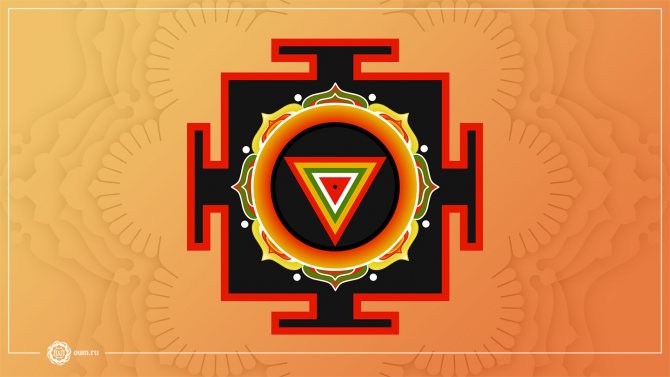

Yantra of the Goddess Kali
Meaning for women.
Less often the tattoo in the form of Kali is chosen by the fair sex. Women more like images in the style of old-school and watercolor. Colorful tattoos for the fair sex will mean:
A beautiful tattoo will be able to tell about the soulfulness and wisdom of a woman.
In addition, such a body image will testify about the faith of its owner. Such a tattoo often means a woman's desire to become a mother or the pride of having children.

